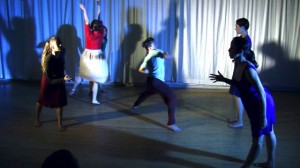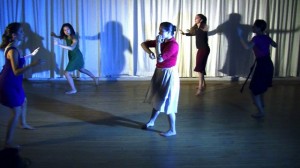Colored Room, White Box, Vivid Dance
 Monica Bill Barnes has been the San Diego dance community’s big “she started here” success story. Barnes trained at UCSD, made a splash in New York with work that’s both funny and poignant, and has been getting national attention touring with NPR’s Ira Glass. (Check out the New Yorker piece about their show, “Three Acts, Two Dancers, One Radio Host.”)
Monica Bill Barnes has been the San Diego dance community’s big “she started here” success story. Barnes trained at UCSD, made a splash in New York with work that’s both funny and poignant, and has been getting national attention touring with NPR’s Ira Glass. (Check out the New Yorker piece about their show, “Three Acts, Two Dancers, One Radio Host.”)
Now there’s a new cause for bragging rights: Randé Dorn. Dorn, also a UCSD graduate, lives in Los Angeles. In August, she brought her Dorn Dance Company t0 the White Box Theater for “Sweat,” a program with multiple choreographers, and the work she showed was thrilling, psychologically complex and with a movement vocabulary so fresh that I couldn’t find a frame of reference for it.
Dorn returned to the White Box Saturday night with a substantial premiere, “The Colored Room,” and a 2013 work, “We, Hanging By A Thread”—and the thrill isn’t gone.
Shown here last month as a partial work-in-progress, “The Colored Room” is a compelling drama of how we connect in communities but often gain a sense of belonging by excluding whoever gets defined as “other.” Five of the six dancers form a circle (a repeated image reminiscent of folk dance), but there’s an odd person out, whether at the circle’s center or isolated to the side. Irene Vallar (tiny and quick, like a darting firefly) gets backed across the room by a bullying pack. There are face-to-face standoffs and times when the one male dancer (Orlando Agawin) seems to court one or another of the women, usually with little success. Dorn also weaves in delectable bits of unison and a taste of early experiences of community via the children’s games “Red Light, Green Light” and “London Bridge.”
 There’s nothing specific in the dance about race, but Dorn says her work is influenced by her experience as a black female artist. And the striking costumes—each dancer has an individual palette of bright solid colors, one for his/her shirt and a different-hued skirt or pants—put me in mind of “the united colors of Benetton” clothing ads with their rainbow of ethnicities, everyone happy and inhabiting a mythical world in which difference no longer matters (though everyone had better be gorgeous). (Note: The photos were taken before the costumes were finalized. In the performance, each dancer had a different-colored shirt and bottom.)
There’s nothing specific in the dance about race, but Dorn says her work is influenced by her experience as a black female artist. And the striking costumes—each dancer has an individual palette of bright solid colors, one for his/her shirt and a different-hued skirt or pants—put me in mind of “the united colors of Benetton” clothing ads with their rainbow of ethnicities, everyone happy and inhabiting a mythical world in which difference no longer matters (though everyone had better be gorgeous). (Note: The photos were taken before the costumes were finalized. In the performance, each dancer had a different-colored shirt and bottom.)
While Dorn draws on familiar images of community like circle dances and kids’ games, her choreography is anything but familiar. She uses the body like no one else, giving her beautifully attuned dancers high-kneed sneaking steps, big slides, extended legs that whip into turns. Arrestingly askew, Maggie Jones walks with a canted hip; and Agawin extends one leg to the front, then leans backward and holds the extension forever as Michelle-Marie Gilkeson ducks under his leg. I couldn’t scribble fast enough to capture all of the choreographic invention.
I had a similar sense of movement discovery in “We, Hanging by a Thread,” in which three pairs dance an argument; one member of the pair points an accusatory finger, then watches as the other “explains.” The finger-pointing may be overly literal, but other movements come in a fabulous cascade: little jumps as at the end of ballet class, scrambling on the floor, frantically shaking rag-doll arms. And Dorn works a lot with levels here, sending dancers corkscrewing to the floor and back up again.
There’s also the treat of live music from cellist Isaac Takeuchi and the multi-talented Dorn herself, doing big, bluesy vocals; the two perform their reimagined version of The Smiths “What She Said.”
[php snippet=2] The evening of riveting dance also included Blythe Barton’s “Umbrage” and an excerpt from Michael Mizerany’s “Relentlessly Yours.” Good matches for Dorn’s psychologically juicy work, both Barton’s contentious five-woman piece and Mizerany’s full-tilt attraction-ambivalence duet suggest that connecting with other humans is a prickly business.
